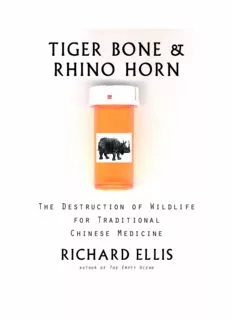
Tiger Bone & Rhino Horn: The Destruction of Wildlife for Traditional Chinese Medicine PDF
Preview Tiger Bone & Rhino Horn: The Destruction of Wildlife for Traditional Chinese Medicine
T I G E R B O N E & R H I N O H O R N The Destruction of Wildlife for Traditional Chinese Medicine R I C H A R D E L L I S author of The Empty Ocean 11555599663355332200..ppddff 11 1122//2299//0055 1111::1144::0066 PPMM A SHEARWATER BOOK 11555599663355332200..ppddff 22 1122//2299//0055 1111::1144::0066 PPMM Also by Richard Ellis The Book of Sharks The Book of Whales Dolphins and Porpoises Men and Whales Great White Shark (with John McCosker) Monsters of the Sea Deep Atlantic Imagining Atlantis The Search for the Giant Squid Encyclopedia of the Sea Aquagenesis Sea Dragons: Predators of Prehistoric Oceans The Empty Ocean No Turning Back: The Life and Death of Animal Species 11555599663355332200..ppddff 33 1122//2299//0055 1111::1144::0066 PPMM Tiger Bone & Rhino Horn 11555599663355332200..ppddff 44 1122//2299//0055 1111::1144::0066 PPMM Although this is an herbal medicine and contains no tiger parts, the package suggests that by using it, one can acquire the tiger’s potency. 11555599663355332200..ppddff 55 1122//2299//0055 1111::1144::0099 PPMM Tiger Bone & Rhino Horn The Destruction of Wildlife for Traditional Chinese Medicine Richard Ellis / Shearwater Books Washington • Covelo • London 11555599663355332200..ppddff 66 1122//2299//0055 1111::1144::0099 PPMM A Shearwater Book Published by Island Press Copyright © 2005 Richard Ellis All rights reserved under International and Pan-American Copyright Conventions. No part of this book may be reproduced in any form or by any means without permission in writing from the publisher: Island Press, 1718 Connecticut Ave., Suite 300, NW, Washington, DC 20009. Shearwater Booksis a trademark of The Center for Resource Economics. Library of Congress Cataloging-in-Publication data. Ellis, Richard, 1938- Tiger bone & rhino horn : the destruction of wildlife for traditional Chinese medicine / Richard Ellis. p. cm. Includes bibliographical references and index. ISBN 1-55963-532-0 (hardback : alk. paper) 1. Medicine, Chinese. 2. Poaching. I. Title: Tiger bone and rhino horn. II. Title. R601.E44 2005 610’.951—dc22 2005002489 British Cataloguing-in-Publication data available. Printed on recycled, acid-free paper A Design by Joyce C. Weston Manufactured in the United States of America 10 9 8 7 6 5 4 3 2 1 11555599663355332200..ppddff 77 1122//2299//0055 1111::1144::0099 PPMM With a seemingly never-ending demand for the keratinous horn in the Orient, the Greater One-Horned Rhinoceros is facing the biggest threat ever to its existence....This is a testament to the fact that rhinoceros horn, more than any other animal-derived medicine...is considered a life-saving traditional Chinese medicine. Vivek Menon, Under Siege The most serious threat presently to tigers’ survival is the use of their bones in Oriental medicine....As wild tiger populations have declined owing to trophy hunting, pest control, and habitat loss, human populations in East Asia have increased dramatically while their per capita expendable income has risen at record rates. At the same time, there has been a resurgence of interest in traditional Asian cures such as tiger bone, the use of which is seen as a status symbol, as a way to retain old customs in the face of rapid change, and as an alternative to the fallibilities of Western medicine. Judy Mills and Peter Jackson, Killed for a Cure China was the first country to utilize bear bile and gall bladder in traditional medicinal products, and this use was adopted by Korea and Japan centuries ago. Today the use of TCM [traditional Chi- nese medicine] is widespread not only in Asia but also throughout Asian communities in other areas of the world, including Europe and America. Many of these consumers buy bear bile products, either because they believe it to be a traditional medicine, or because the products are marketed well by local TCM pharmacies. The trade in gall bladders from wild bears has been extensive over the past few decades. Tens of thousands of bears have been killed in the wild to obtain the gall bladders and other parts, including the paws (a delicacy in some Eastern countries), hide, claws, meat, fat and bones. But the gall bladder has been the prize as it has the greatest commercial value. Tim Phillips and Philip Wilson, The Bear Bile Business 11555599663355332200..ppddff 88 1122//2299//0055 1111::1144::0099 PPMM Contents Preface ix 1 Tyger, Tyger 1 2 Suffer the Animals 10 3 Chinese Medicine, Western Medicine 28 4 Horn of Plenty 71 5 Where Have All the Tigers Gone? 144 6 The Bad News for Bears 203 7 Tigers, Rhinos, and Bears, Oh My! 233 Bibliography 253 Illustration Credits 275 Index 279 ~ vii~ 11555599663355332200..ppddff 1100 1122//2299//0055 1111::1144::0099 PPMM 11555599663355332200..ppddff 1111 1122//2299//0055 1111::1144::0099 PPMM
Description: